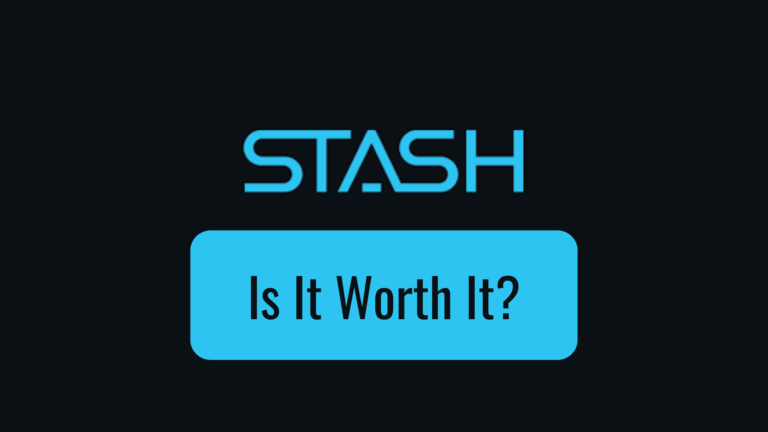Not all investors have the money needed to make a subscription to stock picking services worth the cost.
A well-respected service can cost $200 or more every year. If you’ve only got a few dollars to invest to get started, you may need something that’s more affordable.
And if that’s the case, you may want to consider Stash.
Which leaves the big question:
Is Stash worth it?
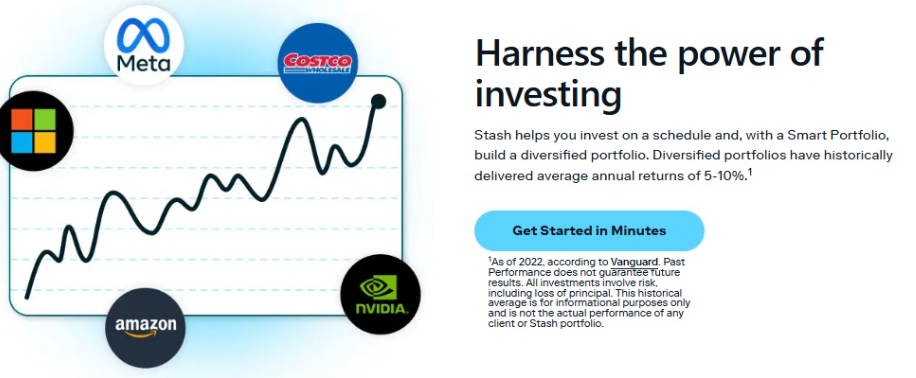
There are lots of factors to take into consideration, including subscription and trading costs, features, available assets, usability, and security.
To help you decide if Stash is the right investing app for you, we’ll review all of these things and more.
Keep reading to get the details you need to make an informed decision about Stash!
What Is Stash? History and Mission
Let’s start with Stash’s origins and history, because there are a few things that truly set it apart from other digital investment platforms.
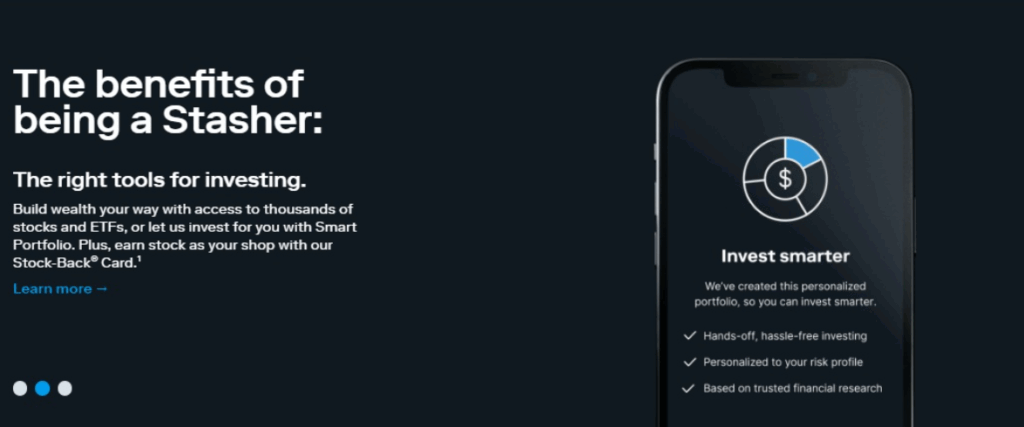
The History of Stash
Stash was founded by two Wall Street guys, Brandon Krieg and Ed Robinson. Both Investment professionals, they recognized a real problem.
Everyday people were being priced out of the stock market.
Let’s face it: it’s hard to diversify a portfolio if you only have enough money to buy one or two shares of stock at a time.
So, instead of the traditional approach. Krieg and Robinson decided to focus on micro-investing, which only requires a few dollars of investment at a time and allows for the purchase of fractional shares.
They added some cool features designed to appeal to new investors, including round-up stock purchases and dividend reinvestment… and that’s how Stash was born.
We should also note that Stash is a registered advisor with the SEC.
Stash’s Mission and Values
In defining Stash’s mission, the company identified four core values. These things help Stash employees focus their efforts in the right place and keep the company’s purpose clear.
- Prioritize People: A people-first approach has helped to build a diverse company culture where everyone learns and grows.
- Obsess Over the Customer: An investment platform only succeeds if its users are happy, so Stash has worked hard to create an optimal user interface and experience to give customers what they need to build a portfolio and create wealth.
- Take Ownership: Members of the Stash team are encouraged to share ideas, innovate and create, and to take ownership of their work.
- Create Solutions: With the customer in mind, Stash team members use their creative energy to solve common problems and challenge the status quo.
This spirit of innovation and the accompanying focus on customer satisfaction are things that set Stash apart from its competitors and help explain why it’s a popular investment app for beginners.
Current Promotion: Create Your Account Today & Get a $5 Bonus!
Use THIS page to open an account & deposit $5. You will then receive your bonus straight to your account.
How Does Stash Work?
We’ve mentioned micro-investing, but what does that mean and how does it work?
As you might be able to guess from the name, micro-investing is a type of investing that starts small. It may involve purchasing fractional shares of stocks and ETFs, or even cryptocurrencies.
The term ‘micro’ may also apply to the overall amount you invest. People with deep pockets or high income might be able to invest thousands of dollars each month. Micro-investing democratizes investing by allowing people to get started with just a few dollars.
If you want to get started with Stash, you can do it with a deposit of just $4 in your account.
With that $4, you can choose to engage in one of two types of investing.
Self-Directed Investing
If you’re someone who wants to make your own decisions about investing, then self-directed investing with Stash is the way to go.
With self-directed investments, you’ll review investment options. You may choose to do a deep dive by viewing earnings call transcripts and financials or by reading articles from respected analysts. You can do some (but not all) of these things on Stash.
Once you’ve done that, you’ll buy the assets you’ve chosen and build your portfolio accordingly. You’ll also be responsible for rebalancing your portfolio to manage your risk.
Smart Portfolio (Robo-Advisor)
Smart Portfolio is Stash’s automated portfolio option: in other words, it’s ideal if you want to use a robo-advisor.
The robo-advisor will choose investments for your portfolio based on the information you provide, including details about your risk tolerance and investment preferences.
One thing we like about the Smart Portfolio option is that it will automatically rebalance your portfolio every three months. You won’t need to worry about taking unnecessary risks due to overinvestment in one asset, industry, or sector.
Current Promotion: Create Your Account Today & Get a $5 Bonus!
Use THIS page to open an account & deposit $5. You will then receive your bonus straight to your account.
What Features Does Stash Have?
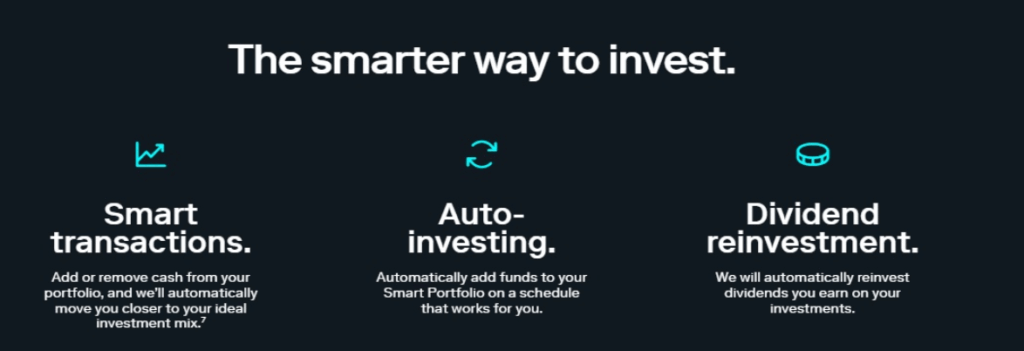
Some of the digital investment platforms and apps out there have a ton of educational and stock analysis features.
Because Stash has a simplified interface that’s ideal for beginners, it’s not as jam-packed with features as some of its competitors.
That said, it’s still got some elements that both beginner and advanced investors may appreciate.
Portfolios
We’ve already mentioned the Smart Portfolio, but subscribers to all plans also get access to Personal (self-directed) and Retirement Portfolios.
There’s no dedicated Environmental, Social, and Governance (ESG) portfolio, so if you care about sustainable investing, you’ll need to choose your own investments accordingly.
Available Assets
Unlike some of its competitors, Stash offers only two major asset categories for investment: stocks and ETFs.
That means you can’t buy bonds, commodities, or cryptocurrencies. You can get some exposure to the bond market by purchasing bond ETFs.
Let’s talk about what that means for your overall investment strategy.
A well-balanced portfolio should contain a mix of assets, including stocks, bonds, and cash. It may also include real estate, commodities, and cryptocurrencies.
Since you can’t buy most of these asset classes on Stash.com, you may need to use more than one tool to create a truly balanced portfolio that aligns with your financial goals and risk tolerance.
Accounts
In addition to portfolio options, Stash also allows users to open several account types, including retirement accounts.
- Cash account: Deposits are FDIC-insured through the Apex Sweep Program up to $250,000
- Traditional IRA (pre-tax contributions)
- Roth IRA (post-tax contributions)
One limitation is that there are no small business or custodial IRAs available.
Banking Features
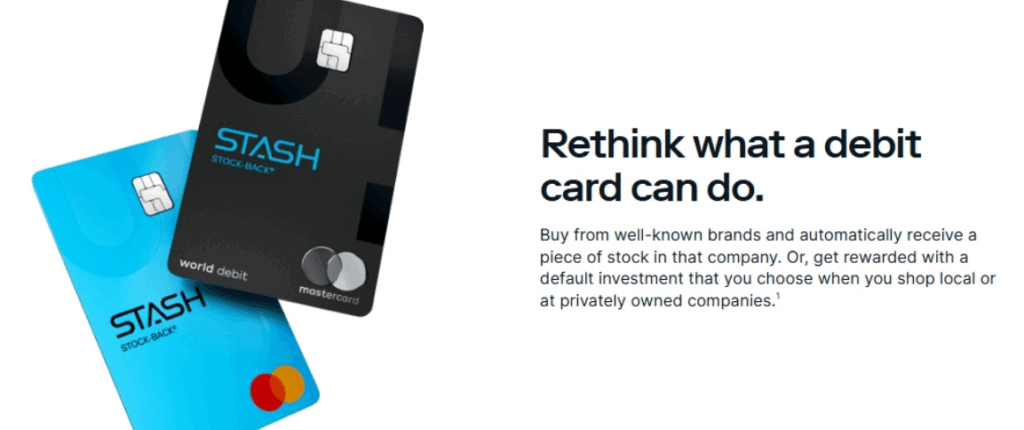
We already mentioned that Stash has some banking features, including an FDIC insurance option thanks to its relationship with Apex Clearing Corporation.
- Stock-Back® Card: Offers 1% to 3% stock rewards with every purchase
- No overdraft fees
- Fee-free access to more than 55,000 ATMs
- Early paycheck access with direct deposit
- Mobile check deposit
- Instant transfers between your bank account and Stash
You’ll get a free Stock-Back® Card with any Stash subscription.
Current Promotion: Create Your Account Today & Get a $5 Bonus!
Use THIS page to open an account & deposit $5. You will then receive your bonus straight to your account.
Automated Investing Options
In addition to what we’ve already mentioned, there are a few other automated features that we think are the true “special sauce” of Stash.
- Stock Round-Up: Every stock purchase you make is rounded up to the nearest dollar and the remainder is added to your portfolio.
- Dividend Reinvestment: When you earn dividends, the proceeds are reinvested in your portfolio to help it grow.
- Stock-Back Rewards: Every subscriber gets a Stock-Back® Card and can earn between 1% and 3% of stock rewards for each purchase.
These features are all designed to help investors build a portfolio and grow their investments and wealth as quickly as possible.
How Much Does a Stash Subscription Cost?
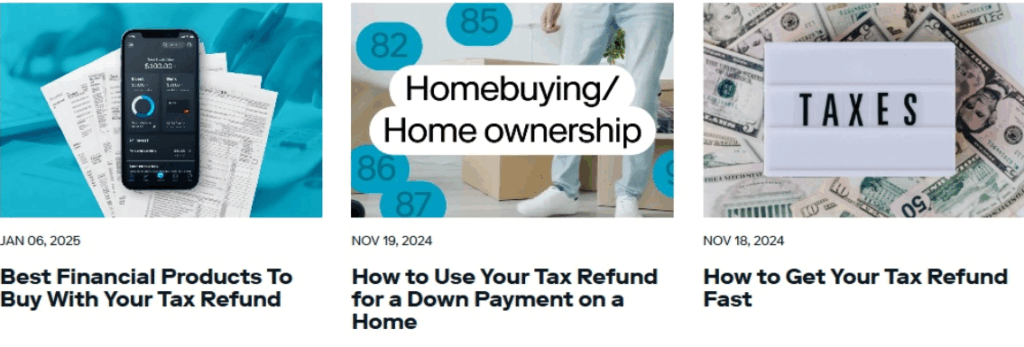
There are two subscription tiers for Stash.
Since the company has committed itself to making investing affordable for everybody, it shouldn’t come as a surprise that both subscription levels are extremely affordable.
The Stash Growth plan costs just $3 per month. It comes with some nice features, including:
- Educational resources designed to help beginners learn about investing, plus general financial advice.
- Access to Personal, Smart, and Retirement Portfolios (including traditional and Roth IRAs)
- Choice between self-directed or robo-advisor portfolios
- Ability to invest in both stocks and ETFs
- Earn 1% stock back with your Stock-Back® Card
- Banking features, including FDIC insurance, early payday, no overdraft fees, and more
- A $1,000 life insurance policy from Avibra
The Stash+ Plan offers some useful additional features and rewards that may make the extra $6 per month a worthwhile investment.
- Stash+ Market Insights for investors who want access to analysis and research
- Kids’ portfolios, great for teaching kids about investing and compounding interest
- Earn up to 3% in stock on purchases with your Stock-Back® Card
- A $10,000 life insurance policy from Avibra
Here’s a chart comparing key differences between the two plans.
| Stash Growth | Stash+ | |
|---|---|---|
| Stock-Back® Card | 1% stock back with every purchase | 3% stock back with every purchase |
| Kids Portfolios | No | Yes |
| Stash+ Market Insights | No | Yes |
| Avibra Life Insurance | $1,000 | $10,000 |
How Does Stash Protect Users?
As we’ve already mentioned, Stash is registered with the SEC. The company is also a FINRA member, as is Apex Clearing Corporation.
Cash deposits are protected by FDIC insurance. Since Apex Clearing is a member of the Securities Investor Protection Corporation (SIPC), users’ investments are insured up to $500,000.
That takes care of regulatory protection and insurance, but what about protecting your accounts?
Like all reputable investment platforms, Stash takes security very seriously. Here are some of the measures they employ to make sure your money, investments, and personal data are safe.
- 256-bit, bank-level encryption
- Transport Layer (TL) security
- Two-factor authentication (2FA)
- Biometric recognition (fingerprint or facial scan)
If you decide to become a Stash subscriber, keep in mind that 2FA is encouraged but not required. You’ll need to log into your account and enable 2FA to protect yourself.
What Do Users Say About Stash?
We always like to glance at user reviews to see what people are saying about the investment apps and platforms we review.
Users on the Google Play Store and Apple Store praise Stash’s user-friendly interface, reinvesting features, and low subscription costs.
Some of the most common complaints have to do with glitches in the app. It looks like Stash used to have a free account option, and some subscribers were automatically switched to a paid plan and took issue with that. Overall, Stash is extremely responsive to both positive and negative feedback and even encourages users to email them at support@stash.com to provide ideas to improve the app or resolve issues as they arise.
Our Conclusion: Is Stash Worth It?
Is Stash worth it?
The short answer is yes, especially if you’re a beginning investor who wants an affordable way to create a portfolio and useful tools to grow your investments and build wealth.
We’d say the answer for advanced investors isn’t as clear. While Stash offers a few analysis tools, it’s not the place for experienced investors who want a way to dive deep into a company’s financials.
If you’re a beginner, then being able to get started with just $4 is a clear benefit. You can buy fractional shares and take advantage of reinvestment options to add to your portfolio regularly.
To learn more about Stash, check out our full, in depth, Stash Review.
FAQs
Setting up a Stash account is quick and easy, and it involves the same steps as opening any investment account. You’ll need to be 18 or older and have a United States bank account, a Social Security Number, and U.S. citizenship, a green card, or certain visas.
Yes, the minimum is $4, which includes $3 for the first payment of your Stash Growth subscription plus $1 to begin investing. If you choose the Stash+ account, you’ll need a minimum $10 deposit.
If you opt for a Smart Portfolio, the robo-advisor will choose stocks and ETFs across a variety of industries and market caps that align with your risk tolerance and preferences. It will automatically rebalance your portfolio every 3 months. Self-directed investing means you’ll be responsible for choosing your own investments and rebalancing as needed. Stash has educational resources to help with that.
Yes, there’s a library of useful articles on a wide variety of investment topics, including asset allocation, stock market terminology, riding out market volatility, and much more.
Ranking of Top Stock Newsletters Based on Last 3 Years of Stock Picks as of September 27, 2025
We are paid subscribers to dozens of stock and option newsletters. We actively track every recommendation from all of these services, calculate performance, and share our results of the top performing stock newsletters whose subscriptions fees are under $500. The main metric to look for is "Return vs S&P500" which is their return above that of the S&P500. So, based on September 27, 2025 prices:
Best Stock Newsletters
| Rank | Stock Newsletter | Picks Return | Return vs S&P500 | Picks w Profit | Max % Return | Current Promotion |
|---|---|---|---|---|---|---|
| 1. |  Alpha Picks | 90.5% | 65.0% | 76% | 1,478% | November, 2025 Promotion: Save $100 |
| Summary: 2 picks/month based on Seeking Alpha's Quant Rating; Retail Price is $499/yr. See complete details and analysis in our Alpha Picks Review. | ||||||
| 2. |  Moby.co | 52.4% | 16.5% | 74% | 2,412% | November, 2025 Promotion: Next pick free! |
| Summary: 60-150 stock picks per year, segmented by industry; Retail Price is $199/yr. Read our Moby Review. | ||||||
| 3. |  Zacks Top 10 | 35.3% | 16.4% | 76% | 170% | November, 2025 Promotion: $1, then $495/yr |
| Summary: 10 stock picks per year on January 1st based on Zacks' Quant Rating; Retail Price is $495/yr. Read our Zacks Review. | ||||||
| 4. |  TipRanks SmartInvestor | 20.8% | 9.4% | 63% | 430% | Current Promotion: Save $180 |
| Summary: About 1 pick/week focusing on short term trades; Lifetime average return of 355% vs S&P500's 149% since 2015. Retail Price is $379/yr. Read our TipRanks Review. | ||||||
| 5. |  Stock Advisor | 46.0% | 7.6% | 74% | 330% | November, 2025 Promotion: Get $100 Off Get 3 Picks Free |
| Summary: 2 picks/month and 2 Best Buy Stocks lists focusing on high growth potential stocks over 5 years; Retail Price is $199/yr. Read our Motley Fool Review. | ||||||
| 6. |  Action Alerts Plus | 26.2% | 4.9% | 65% | 208% | Current Promotion: None |
| Summary: 100-150 trades per year, lots of buying and selling and short-term trades. Read our Jim Cramer Review. | ||||||
| 7. |  Zacks Home Run Investor | 5.1% | 0.1% | 46% | 299% | November, 2025 Promotion: $1, then $495/yr |
| Summary: 40-50 stock picks per year based on Zacks' Quant Rating; Retail Price is $495/yr. Read our Zacks Review. | ||||||
| 8. | IBD Leaderboard ETF | 11.4% | -1.8% | n/a | n/a | November, 2025 Promotion: None |
| Summary: Maintains top 50 stocks to invest in based on IBD algorithm; Retail Price is $495/yr. Read our Investors Business Daily. | ||||||
| 9. |  Zacks Under $10 | 2.0% | -2.1% | 38% | 263% | November, 2025 Promotion: $1, then $495/yr |
| Summary: 40-50 stock picks per year based on Zacks' Quant Rating; Retail Price is $495/yr. Read our Zacks Review. | ||||||
| 10. |  Hidden Gems | 35.6% | -3.1% | 69% | 240% | Current Promotion: Save $200 |
| Summary: 5 picks/month focusing on disruptive technology and business models; Lifetime average return of 355% vs S&P500's 149% since 2005; Now part of Motley Fool Epic. Read our Motley Fool Epic Review. | ||||||
| Top Ranking Stock Newsletters based on their last 3 years of stock picks covering 2025, 2024, 2023, part of 2022 performance as compared to S&P500. S&P500's return is based on average return of S&P500 from date each stock pick is released. NOTE: To get these results you must buy equal dollar amounts of each pick on the date the stock pick is released. Investor Business Daily Top 50 based on performance of FFTY ETF. Performance as of September 27, 2025. | ||||||
